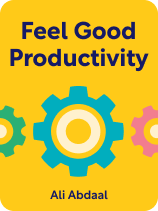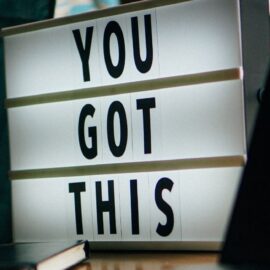

This article is an excerpt from the Shortform book guide to "Feel-Good Productivity" by Ali Abdaal. Shortform has the world's best summaries and analyses of books you should be reading.
Like this article? Sign up for a free trial here.
Do you feel like you’ve given everything you have at work? What are the three types of burnout?
Ali Abdaal says that burnout sets in when work stops feeling good and starts to feel tedious, meaningless, or overwhelming instead. This means that your work is harming your emotional well-being instead of boosting it.
Let’s go over the three types of burnout and how to overcome them.
Burnout Type #1: Strain
To begin his discussion on the three types of burnout and how to overcome them, Abdaal talks about strain. Strain happens when you’re simply trying to do too much; even the positive energy you get from feel-good productivity has limits. So, just like exercising too much can cause you to strain a muscle, doing too much can cause you to “strain” your well-being.
You can avoid or recover from this type of burnout by taking a healthier approach to your day-to-day work. This is simple in theory, but it can be difficult in practice, so Abdaal offers some tips.
Prioritize, and Be Honest About Your Priorities
First, be honest with yourself and others about how much you can do. Make a list of all the projects you’re working on—both professional and personal—and see if it’s realistic based on how much you can comfortably get done.
If you find that you’re regularly shifting into the grind mindset to meet all your commitments, then you’ve taken on too much and may be heading for burnout. In that case, it’s time to prioritize and simplify. Which projects on that list are most important to you? If you had to pick just one project to devote yourself to, which one would it be?
Abdaal adds that, to avoid this type of burnout, you need to get comfortable with telling people “no.” Remember that other people don’t know exactly how much work you’re doing or how much energy you have, so they’ll often ask you to take on more work when that isn’t feasible for you. Trying to please everyone is a sure way to burn yourself out.
Choose Your Distractions Carefully
Abdaal’s second suggestion for avoiding burnout due to strain is to manage your distractions, because shifting your attention from one thing to another (task-switching) too frequently uses up your mental energy.
Crucially, the author doesn’t say that you should remove all distractions from your life. For one thing, that’s impossible; for another, occasional breaks actually improve your focus when you get back to your main task. However, he does suggest indulging in distractions that make you feel good, instead of distractions that simply fill time.
Abdaal says it’s likely that managing distractions means rethinking your relationship with technology, especially with your phone. When you have a smartphone, you’re constantly bombarded with distractions such as emails, app notifications, and social media feeds. Therefore, Abdaal suggests uninstalling any apps that you can live without and setting strict limits about when and how much you’ll use your phone for things like emails.
So, instead of checking your phone or browsing your favorite websites whenever you need a break, try looking for positive distractions. For example, you could try stretching, taking a walk, reading an uplifting book, or talking to a friend.
Burnout Type #2: Drain
Abdaal’s second type of burnout is a counterpart to the first: Whereas strain happens when you work too much, drain happens when you don’t get enough rest after working. Naturally, this can happen because you don’t take enough time for yourself—however, the problem could also be that you’re not resting in a way that’s truly restorative.
Abdaal explains that effective types of rest help you to feel calm and (temporarily) free of any demands on your time or energy. Each person is different, so only you can discover exactly what works for you. For example, some people find playing video games to be restful, while others prefer creative hobbies like writing or drawing, and still others enjoy going out to the bar or playing sports with their friends.
(Shortform note: Although rest looks different for every person, in his book Focus, psychologist Daniel Goleman provides a helpful guideline: Activities where you can passively take in what’s happening will help to restore your mental energy. For instance, watching a movie, reading a book, or taking a walk have this type of restorative effect. Conversely, activities that force you to concentrate, analyze information, and make decisions further drain your mental energy. For example, an intense strategic game like Crusader Kings may be enjoyable, but it’s not likely to give your brain the rest it needs after a long day of work.)
Most importantly, says Abdaal, whatever your preferred methods of rest are, don’t let them turn into more work. The grind mindset will try to creep in and tell you that your hobbies are a waste of time if you’re not making money with them. However, Abdaal points out that when your hobby becomes your “side hustle,” it no longer restores your energy—instead, it places even more demands on you and makes you burn out even more quickly.
(Shortform note: Workaholics—people who have the grind mindset deeply ingrained—tend to fight against resting because they want to spend that time being productive instead. Therefore, it’s helpful to understand that resting is productive; being well-rested makes you more creative, more efficient, and better able to solve problems. So, if the idea of taking time to rest makes you uncomfortable, try reframing rest as another task that you need to accomplish each day. Alternatively, think of it as an investment: The time you “spend” resting now will pay dividends in productivity later.)
Burnout Type #3: Mismatch
Abdaal’s final type of burnout, mismatch, happens when your work doesn’t line up with your interests and principles. If what you’re doing feels meaningless, that’s a clear sign you’re headed for this kind of burnout.
The easiest way to tell whether you’re suffering from mismatch is to think about why you’re working on something; in short, what’s motivating you? If your only motivation is some kind of reward, such as a paycheck, prestige, or someone else’s goodwill, then the task isn’t a good match for you.
On the other hand, if your feelings are helping to drive you—if you’re excited to work on that task, or you’d be willing to do it even without any reward—then your actions are properly aligned with your goals.
Abdaal saves mismatch burnout for last because it’s the most difficult to avoid and to recover from. He says that matching what you do with what you want is a lifelong process that needs frequent self-evaluations and adjustments.
| How to Figure Out What You Want Abdaal’s advice to match what you do with what you want closely resembles the concept of ikigai, a Japanese word that roughly translates to “life’s purpose.” In their book Ikigai, self-help authors Héctor García and Francesc Miralles go into greater detail about how to find your ikigai. According to the authors, a fulfilling and sustainable ikigai must have four elements: 1. Passion: It must be something you love to do. 2. Skill: It must be something you’re good at doing. 3. A Cause: It must be something you genuinely believe will benefit others, or make the world a better place. 4. Profit: It must be something you can make money doing. If you aren’t sure what your life’s purpose is, you could start looking for it by making separate lists for each of those four elements, then finding connections between the items on those lists. Anything that meets all four criteria will be a strong candidate for your ikigai. |

———End of Preview———
Like what you just read? Read the rest of the world's best book summary and analysis of Ali Abdaal's "Feel-Good Productivity" at Shortform.
Here's what you'll find in our full Feel-Good Productivity summary:
- How to stop procrastination at its source and avoid or recover from burnout
- The crucial link between emotional health and productivity
- How to work in ways that feel energizing instead of draining






